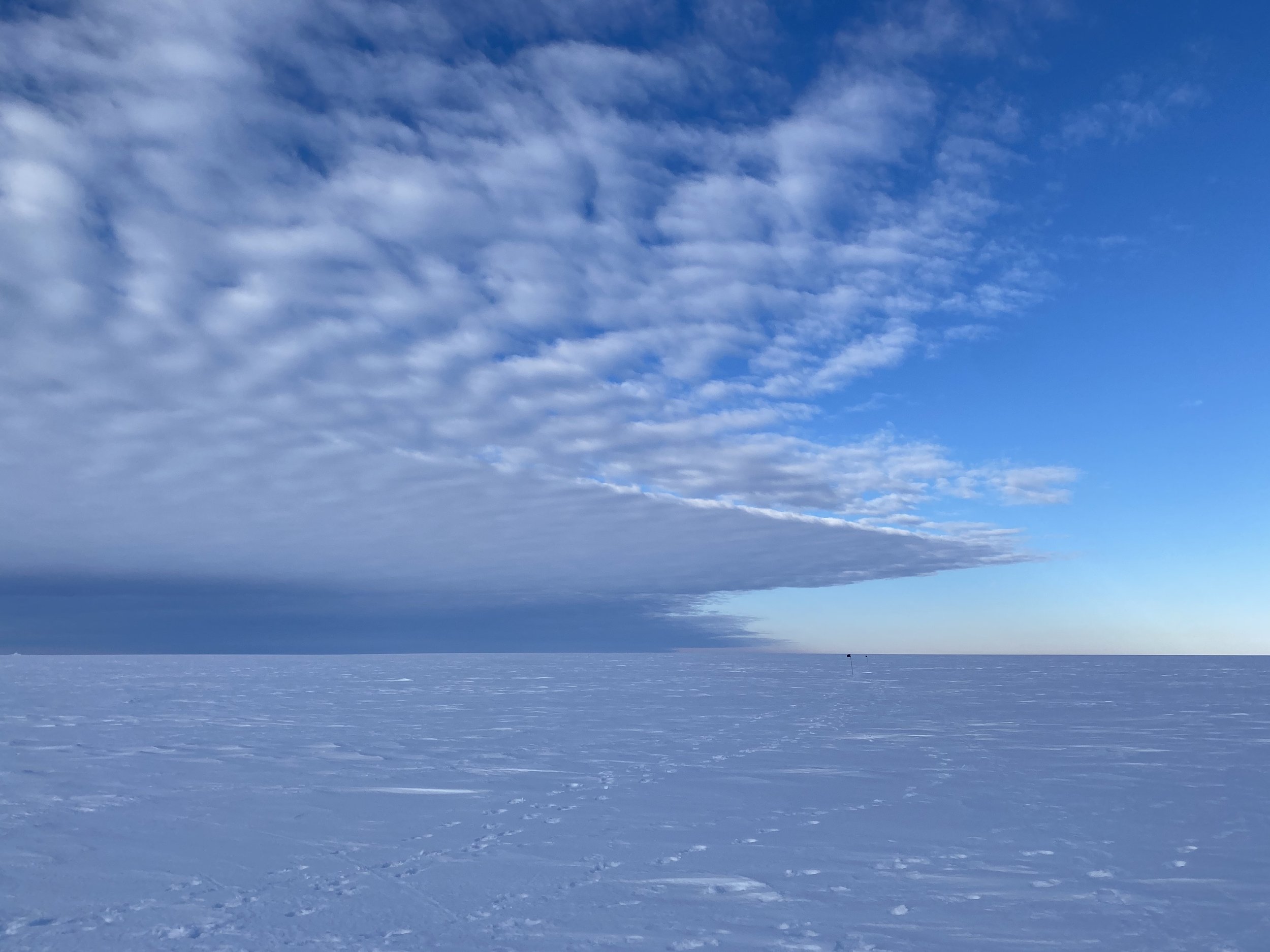
My Research
Current Research
Antarctic Atmospheric Rivers in Present and Future Climates
In Antarctica, atmospheric rivers (ARs) are rare, intense events where large quantities of moisture in the atmosphere are transported onto the ice. Despite their rarity, ARs play an important role in the Antarctic climate by causing intense snowfall and bringing warm conditions, associated with rainfall and surface melting. These mixed impacts mean that while ARs primarily help to replenish ice loss from Antarctica through snowfall, mitigating sea level contributions, they can also produce adverse impacts on the surface. Therefore, quantifying how ARs and their impacts may change in a warming climate is crucial in producing estimates for future Antarctic contributions to sea level rise.
In this study, we use 40 simulations from a high-resolution climate model (the CESM2 large ensemble) to assess the occurrence and impacts of ARs in the present-day and at the end of the 21st century under moderate warming. We find that there is a large increase in atmospheric moisture in response to increasing temperatures, which makes it far easier for future events to reach today’s threshold for what is considered extreme, leading to a doubling of AR frequencies and 2.5x increase in precipitation. Conversely, when raising the threshold for ARs to account for increasing moisture, we find their frequency and precipitation impacts are comparable to the present-day. This suggests that the future role of ARs in the Antarctic climate system is highly dependent on how ARs are defined and detected, though it is clear that the increase in atmospheric moisture in response to global warming exerts a major influence on the occurrence and impacts of these intense events.
These results were recently published in Communications Earth & Environment:
Maclennan et al. (2025). Rising atmospheric moisture escalates the future impact of atmospheric rivers in the Antarctic climate system. Nature Communications Earth & Environment. doi: 10.1038/s43247-025-02333-x
a Present-day average annual AR frequency among all 40 ensemble members in CESM2 (1980–2014). b Model AR frequency bias (CESM2 minus MERRA-2 reanalysis) in the present (1980–2014). c Future AR frequency difference in CESM2 (2066–2100 minus 1980–2014) when future AR detection is solely based on the present-day vIVT threshold. d Future AR frequency difference in CESM2 (2066–2100 minus 1980–2014) when the present-day threshold for AR detection is scaled by the ensemble mean relative increase in IWV. Maclennan et al. (2025)
MODIS Corrected Reflectance showing clouds and atmospheric circulation around Antarctica on 07 February 2020 NASA Worldview Database
Past Projects
Meteorology of Thwaites Eastern Ice Shelf
As part of the International Thwaites Glacier Collaboration, two automatic weather stations were installed on Thwaites Eastern Ice Shelf (West Antarctica) in January 2020. These weather stations produced an invaluable record of snow accumulation, temperature, winds, and surface pressure in this remote region of the world.
We used these observations in two ways:
To compare with atmospheric reanalyses, such as ERA5 and MERRA-2. These helped us understand what types of weather patterns may be missed by the reanalyses, which we use frequently to analyze the weather and climate in West Antarctica.
To track a unique event called an “atmospheric river family”. This event involved a series of 3 atmospheric rivers that made landfall over the ice shelf in rapid succession, just 2 weeks after the automatic weather stations were installed. We performed a deep analysis of the large scale drivers, surface characteristics, and snowfall and melt impacts of the event.
Two publications are associated with this study of extreme snowfall on Thwaites Eastern Ice Shelf and its large-scale atmospheric drivers:
Maclennan et al. (2023). Climatology and surface impacts of atmospheric rivers on West Antarctica. The Cryosphere. doi: 10.5194/tc-17-865-2023
Maclennan and Lenaerts (2021). Large-Scale Atmospheric Drivers of Snowfall over Thwaites Glacier, Antarctica. Geophysical Research Letters. doi: 10.1029/2021GL093644
Map of Antarctica showing the location of Thwaites Eastern Ice Shelf.
Automatic Weather Station on Thwaites Eastern Ice Shelf, Antarctica.
Impacts of Atmospheric Rivers on Antarctic Precipitation
Here we performed a comprehensive analysis of the impacts of atmospheric rivers (ARs) on precipitation (snowfall and rainfall) over Antarctica. While ARs are extremely rare in Antarctica, occurring only ~1% of the time, we found that they produce significant impacts on the surface mass balance of the ice sheet. ARs are associated with 13% of the total annual precipitation over Antarctica, and 35% of the year-to-year variability in precipitation. To complement this analysis of Antarctic AR impacts, we also compared different AR detection algorithms for Antarctica and the Southern Ocean, and examined AR links to modes of atmospheric variability.
For full results, see the studies:
Maclennan et al. (2022). Contribution of Atmospheric Rivers to Antarctic Precipitation. Geophysical Research Letters. doi: 10.1029/2022GL100585
Shields et al. (2022). Evaluating Uncertainty and Modes of Variability for Antarctic Atmospheric Rivers. Geophysical Research Letters. doi: 10.1029/2022GL099577
(a) Relative contribution of atmospheric rivers to the mean annual precipitation, by glacier basin. (b) Contribution of atmospheric rivers to the inter-annual variability in precipitation. Maclennan et al. (2022)





